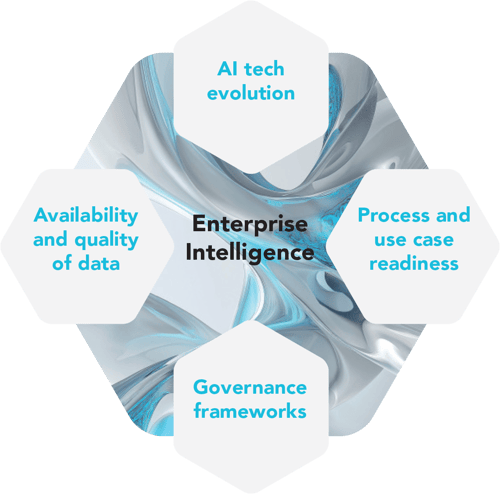The era of Copilots, which began with the everyday use of generative AI, is quickly transitioning into the era of independent AI. This shift lays the foundation for business intelligence – the ability to delegate parts of complex processes to AI.
The breakthrough initiated by ChatGPT in 2022 brought applications based on large language models into office software – everyone is already familiar with Copilot. This Age of Copilot is already significantly transforming how work is done, but it is only the tip of the iceberg in the ongoing AI revolution.
We believe that the transition from the Age of Copilots to the Age of Increasing Independent AI will occur between 2025 and 2030. Gradually, AI will evolve from its current form into an independent performer of core business processes. By the end of this period, AI will be integrated into a company’s core operations, becoming an enabler of the business itself.
Our role is to facilitate our customers' journey through the necessary developments in business, capabilities, skills, and technology. An intelligent enterprise is ready for the Age of Increasing Independent AI and Embedded AI – ready to integrate AI into their work and management processes.

Data Availability and Quality are Crucial
The availability and quality of a company's own data are the essential factors that enable AI to become independent and seamlessly integrate into the company's operations and processes.
An intelligent enterprise designs its business in a way that ensures data availability and quality in every situation of business change and development. This transformation requires a well-constructed IT architecture, smooth integrations – and data-driven business design.
It's no use staying stuck in the '90s when it comes to data availability: Even if business processes produce data gems, they only benefit the whole if the data can be accessed in real-time for reporting, the necessary applications, and to support AI. Business and process innovations emerge from data that flows efficiently and purposefully throughout the organization.
AI is 'Just' a Building Block for Processes
In the frenzy of generative AI pilots, language models were seen as magic dust that could be sprinkled to solve any problem. Many pilots that failed to deliver have revealed a crucial truth: recognizing the business benefits of AI must be taken to a new level.
The key is to ask higher-quality questions about the company’s core functions: In what cases do we, or our customers, benefit from AI? What results can we reasonably expect? How are the risks related to AI managed? How does the human factor fit into the process?
AI needs a clearly defined role, where it is given problems that are appropriately sized for it to solve. The necessary inputs and outputs must be anticipated in advance, and quality-related issues and risks need to be managed through traditional process development methods.
Early signs of success in this transition are emerging in our discussions with clients in the manufacturing industry: nearly delay-free data transfer is breaking down data silos between IT systems and production equipment. The merging of IT and OT data streams is leading even manufacturing industries into the era of autonomous AI and digital twins.
As real-time data begins to flow into training algorithms that guide production, AI will gradually integrate into the core processes of production and business.
Manage the Big Picture in an AI Center of Excellence
Trust in AI isn’t, and shouldn’t be, one hundred percent. Especially today’s GenAI models are good ingredients for solutions, but their behavior in the recipe isn’t fully reliable. A governance framework is needed around them: understanding how AI works, its biases, risks, regulations, and so on. Today’s understanding won’t last long either, as both technology and the regulatory environment are evolving rapidly.
In companies, expertise should be centralized in an AI Center of Excellence (AICoE). The center should be responsible for understanding AI projects, coordinating technology development, and managing AI – including aspects such as AI ethics, the EU AI Act, and industry-specific regulations. If the organization doesn’t yet have a dedicated function for data-driven business development, it will naturally grow alongside the AICoE, as AI work without a strong grip on data proves challenging.
The center ensures that AI investments are properly targeted: production efforts are focused on where value can already be generated, and development funds are directed to areas with the greatest potential for significant competitive differentiation.

Investing at the Right Time in Enterprise Intelligence
New AI applications, business promises, and technological silver bullets are emerging in the public eye almost daily. The key is to identify the technologies that are essential for developing a company's data and AI capabilities, and those that are neither necessary nor timely at the moment.
Today, many of the key investments on the AI journey are not even in AI itself, but in the readiness to adopt it – both in terms of technological capability and employee skills. Tools like Copilot are already enhancing everyday office work, but transforming entire processes starts from deeper levels. For example, Microsoft Fabric, Power BI, and Power Apps are crucial tools for data and process management, through which the deeper applications of AI will emerge in the coming years. Building readiness for these changes now is essential to capture value from AI technologies as soon as they become commercially viable.
Investments in the cornerstones of business intelligence lay the foundation for an organization’s journey from supporting AI to the era of autonomous and embedded AI. With these tools, we enable our customers to transition from support AI to the age of AI independence and integration.


